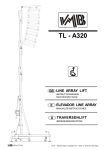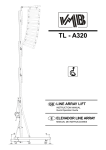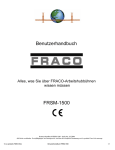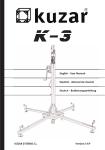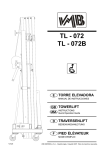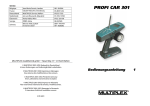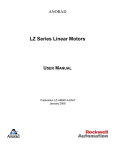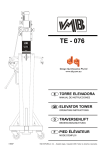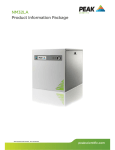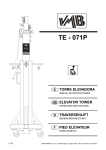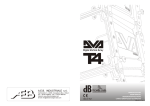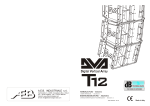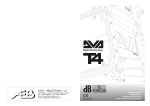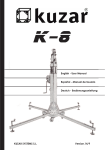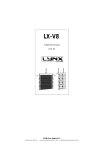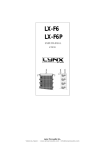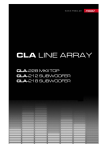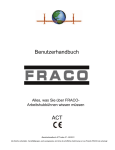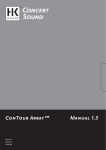Download TL - A220
Transcript
TL - A220 GB LINE ARRAY LIFT INSTRUCTION MANUAL Quick Operation Guide E ELEVADOR LINE ARRAY MANUAL DE INSTRUCCIONES D TRAVERSENLIFT BEDIENUNGSANLEITUNG PRO LIFTS S.L. V.11.03 - Depósito legal y Copyright 2011. Todos los derechos reservados. TORRE ELEVADORA TOWERLIFT TRAVERSENLIFT PIED ÉLÉVATEUR TL-A220 Fabricante - Manufacturer - Hersteller - Fabricant PRO LIFTS S.L. Calle 7 final - Pol. Ind. Picassent E-46220 Picassent (VALENCIA) SPAIN www.prolifts.es - [email protected] Este manual de usuario y catálogo anexo de piezas de repuesto es propiedad de PRO LIFTS S.L. Queda prohibida su reproduccion total o parcial por cualquier medio que la tecnología actual permita. Depósito legal y Copyright 2008. Todos los derechos reservados. TL-A220 X E ALS BU ALS P1 W C J J BA S BU P1 ILS F H D B R H P Q T V PRO LIFTS S.L. V.11.03 - Depósito legal y Copyright 2011. Todos los derechos reservados. Quick Operation Guide CONTENTS 1. 2. 3. 4. 5. 6. 7. 1. ENGLISH During the life of this towerlift, it may need spare parts for maintenance. In this case please contact your distributor. Only original spare parts must be used. The user loses all rights to warranty if any spare parts other than originals are used or carrys out any modification or alteration to the towerlift. Introduction. Technical Data. Security. Instructions. Maintenance. Warranty. Certifications. For any questions relating to this towerlift please indicate serial number and year of production. INTRODUCTION Thank you for choosing VMB Towerlifts. You have acquired a first class, quality product used by professionals around the world. 2. TECHNICAL IINFORMATION To be able to work with this tower, lifting and flying PA and Line Array, please pay special attention to this manual. Please observe the technical data and follow all instructions fully for a correct and safe use. This manual should also be made available and remain with the towerlift. 2.2 - Especially designed for lifting and flying Line array directly from the floor to a height of 5.5m (18’). Able to hang at 50cm (1.6’) from the main body of the lift. All VMB towerlifts undergo a strict quality control to guarantee maximum safety and durability. 2.4 - Minimum Load : Can lift or lower without load. The TL-A220, has been especially designed and engineered to hang Line Array to a maximum height of 5,5 m and a load of 220kg. This lift is capable of situating the PA 50cm from the body of the lift. The benefit of placing the load at a distance enables the user to achieve the perfect curve and coverage for the Line array flown. 2.5 - Maximum Height : 5,5 m (18’). The TL-A220, incorporates the ALS system (Auto-Lock-Security) and ILS system (InertiaLock-Security) all exclusive to VMB and which guarantee the load will not fall and provide complete security. ATTENTION: Do not use this towerlift if you have not read and understood the instructions. PRO LIFTS S.L. 2.1 - Towerlift mod. TL-A220 2.3 - Maximum load : 220Kg (485lb). at 50cm (1.6’) from lift body.. 2.6 - Folded Height : 1,72 m (5.6’). 2.7 - Base Surface : 2.1 x 1.6m (6.9 x 5.2’). 2.8 - Transport Weight : 95Kg (209lb). 2.9 - Construction Material : 6082-T6 aluminium for the main body comprised of 4 profiles and lifting carriage. DIN 2394 steel for the base and outriggers. ST-37 steel for the ALS security system and pulleys. 2.10 - Security Systems: ALS (Auto-LockSecurity), ILS (Inertia-Lock-Security) which guarantee complete security at all times. V.11.03 - Depósito legal y Copyright 2011. Todos los derechos reservados. Quick Operation Guide ENGLISH 2.11 - 900 kg Manual winch with automatic disc brake. 2.15 - Spirit level to adjust vertical positioning. 2.16 - All lift elements are finished in polyester satin black. 2.12 - Cable : DIN 3060 steel. 180 Kg/mm2 quality antitorsion. 5 mm diametre. 2.17 - 360º Wheels for ease of transport to work place. 2.13 - Adjustable stabilisers on the outriggers with anti-slip injected rubber base. 2.14 - Outriggers fixed with security locks. 3. SAFETY PRECAUTIONS. ! 3.1 - The TL-A220 is designed for lifing Line Array and should never be used for elevating persons. 3.2 - Only situate the lift on hard, flat surfaces checking that it is in a vertical position with the spirit level (F) included. If necessary, adjust with support stabilisers (Q) by turning the handle (H). Do not use any other materials to balance the lift. 3.3 - Check all outriggers are inserted correctly and locked with security locks. PRO LIFTS S.L. V.11.03 - Depósito legal y Copyright 2011. Todos los derechos reservados. Quick Operation Guide ENGLISH 3.4 - Never elevate the Line Array before checking it is correctly attached to the lift. Kgs 3.5 - Never exceed the maximum weight indicated on the towerlift and in this manual. 3.6 - If there is excessive wind, place the lift on firm ground and attach slings to add stability. Never attach a sling to a vehicle or any other element than can move. 3.7 - Do not use a ladder on the lift. 3.8 - Be carfeful of any high, obstructions such as balconies, signs etc. It is important to avoid the presence of cables beneath the working position of the lift. PRO LIFTS S.L. V.11.03 - Depósito legal y Copyright 2011. Todos los derechos reservados. Quick Operation Guide ENGLISH 3.9 - Never stand below the raised material and do not allow others to stand beneath or around the working area of the lift. 3.10 - Never try to move the lift once the load is raised. 3.11 - Never use the lift on a mobile surface or on any vehicle. 3.12 - Before using the lift check the condition of the cable. The cable should not be broken or torn. NEVER use defect cables and if in doubt change the cable. Only use DIN 3060 steel cable 180 Kg/mm2 quality torsion resistant cable. 3.13 - Never remove the handle from the winch if the lift is elevated with load. PRO LIFTS S.L. V.11.03 - Depósito legal y Copyright 2011. Todos los derechos reservados. Quick Operation Guide ENGLISH -25 3.14 - The minimum load for the brake functioning in the winch is 25kg. Without this weight the brake will not function. 3.15 - Do not grease or lubricate the break mechanism in the winch. The break discs have been especially greased with a special anti heat, pressure material. Other products must not be used so as to avoid the break not working effectively. 3.16 - All profiles must be lowered before the lift is transported. 3.17 - Only original spares must be used. O R IG INAL PRO LIFTS S.L. V.11.03 - Depósito legal y Copyright 2011. Todos los derechos reservados. Quick Operation Guide ENGLISH 4. INSTRUCTIONS. 4.1 - Situate the lift on its transport wheels (T) upon a flat and stable surface. When erecting the lift in open air, the risk of wind is prevalent. Where wind speeds exceed 30 Km/h it is essential to tie the lift. 2 lateral eye bolbs (X) are situated at the top of profile 2, where tensors should be attached and fixed on secure and firm ground (NEVER ON A VEHICULE OR ANYTHING THAT CAN MOVE). 4.2 - Remove the outriggers from their transport compartments (S) and place them in the working position (V) ensuring they are fixed with the security locks (R). The long outriggers are placed at the front beneath the load. The short outriggers are placed at the back. 4.3 - Remove the front support bars (BA) from their transport compartment (S) and place them in their corresponding fixed position (D) on each front outrigger and at the top of the first profile (E) ensuring they are fixed with the pins provided BU/P1. To correctly fix the front support bars (BA), adjust the support of the front outrigger by turning the stabiliser handel in the necessary direction. Insert clips (BU) and security pins (P1). Adjust the vertical position of the lift with the stabilisers (Q) turning the handels so that the spirit level is centred (F). Support FAS-01 is to be fixed to the forks by either 1 or 2 points. See fig. 1. If the Line Array fliyiyng grame has 4 link points use the FAS-02 support which enables the Line Array to be flown from 4 points, see fig. 2. Both supports FAS-01 and FAS-02 are inserted on the forks as follows: The Line Array cabinets will be attached to their fliying grame with the angles calculated according to the acoustic coverage required. This ensures the Line Array cabinets can be curved in function with the necessary degrees required between them. The system should be attached at the necessary distance to achieve the required curve. The last cabinet should not hit the body of the lift. See fig. 3. To ensure the maximum security margin it is necessarry to always attach the Line Array at the minimum distance possible from the body of the lift. This will mean that the bottom cabinet is as close as possible to the body of the lift. See fig. 3A. To avoid overloading do not seperate uneccessarily the Line Array from the body of the lift. See fig. 3B. 4.4 - Let go of transport security B, remove the forks and place them horizontally. Place the lifting carriage at the required height so that the Line Array fliying grame can be attached. The careful positioning of the front outriggers enables the Line Array to fit between them and ease assembley on to the forks. PRO LIFTS S.L. V.11.03 - Depósito legal y Copyright 2011. Todos los derechos reservados. Quick Operation Guide ENGLISH FAS-01 GS-0,8 PR-01 Fig. 1 FAS-02 PR-01 GS-0,8 MO-C2 MO-C2 Fig. 2 PRO LIFTS S.L. V.11.03 - Depósito legal y Copyright 2011. Todos los derechos reservados. Quick Operation Guide ENGLISH A B TL-A220 TL-A220 Fig. 3 BC-075L MR-SP1 PR-01 PAS-SP1 MR-PAS MO-C2 PAT-02 GS-0,8 FAS-01 PRO LIFTS S.L. FAS-02 V.11.03 - Depósito legal y Copyright 2011. Todos los derechos reservados. Quick Operation Guide ENGLISH 4.5 - The maximum load of the TL-A220 is 220 Kg with the load point at 50 cm from the lift’s body. The loading point capacity can be found on the vertical line which marks the centre of gravity of the Line Array wich is to be flow. The situation of the centre of gravity depends upon the chosen Line Array and is necessary to calculate before use. Never the less, it is usually situated at the centre of the Line Array. See example Fig. 4; 8 Lynx LX-F6 cabinets with a total of 200 Kg. Never overload the lift above the stated maximum weight of 220 Kg. See Fig. 5. Fig . 5 50 cm LYNX LX-F6 (200 Kg.) TL-A220 Fig. 4 PRO LIFTS S.L. Fig. 6 V.11.03 - Depósito legal y Copyright 2011. Todos los derechos reservados. Quick Operation Guide 4.6 - The TL-A220, can also be used as a conventional towerlift. If you are using it as a conventional towerlift always place the load as close to the body as possible. 4.7 - Elevating the lift: Once the Line Array is attached to its flying frame and in the desired position on the forks it is ready to be lifted to the required height. Turn the winch handle in a clockwise direction to elevate the lift. The lifting carriage will rise first. When it reaches the top the first section will rise along with the other sections until the ligt has reached its maximun height of 5,5 m. The ILS and ALS enable the lift to automatically block the carriage and profiles whilst rising ensuring that it will never fall. The lift, with the Line array attached will remain fixed at all times. Once the system is elevated to its required height gently turn the handle in a clockwise direction. The security systems will ensure that the load stays fixed and blocked. The red ALS locks will be blocked. This enables the cable to be without any force and means it is only used for the elevation and descent of the lift. The following instructions will help you to bring the system down. 4.8 - Descending the lift: To bring the lift down you need to first turn the winch handle slightly clockwise and at the same time pull out the red ALS lock in (G). (Fig. 7) This releases the blocking systems. Then turn the handle anti clockwise, whilst maintaining the ALS lock pulled out in until the profile has been completely lowered. PRO LIFTS S.L. ENGLISH G Fig. 7 All red ALS locks should be pulled out one by one whilst the handle is turned anti clockwise and the profiles are brought down, one by one. If you release your finger from the ALS lock it will automatically block. In this case, repeat the first operation by turning slightly clockwise and then anti clockwise whilst always pulling the red ALS lock in. It is necessary to completely lower each profile before starting to lower the next. If you push another red ALS lock without having completely lowered the previous profile the first profile will remain blocked by the security system and you will not be able to lower it later. If this happens, elevate the towerlift to the locked position and free the lock so that you can commence the descent again until it is completely lowered. Finally, release the carriage lock following the same principle as before and lower it to the required level to be able to dismount the Line Array from the lift. 4.9 - Transport Once all the profiles are completely lowered remove the FAS-01 or FAS-02 support and the forks placing them in their horizontal position facing down. Lower the carriage so that right fork can be fixed and blocked for transport (B). Remove the front support bars ( BA ) by taking out the pins (BU). Replace the pins in the top support ( E ) of the lift’s base profile and also at the top of each front support bar. V.11.03 - Depósito legal y Copyright 2011. Todos los derechos reservados. Quick Operation Guide ENGLISH Place the bars in their transport compartment. Remove the outriggers, releasing the locks and place in their transport position (S). Turn and tighten the fixing screws (J). The lift can be transported horizontally by adding the RH-2 kit. 5.3 - All lifts should undergo an annual technical inspection carried out by an authorized VMB dealer to check the certifications and general condition of all the lift’s elements and security systems involved in the lift’s use. 5. MAINTENANCE. 5.4 - Only use original spare parts to guarantee a continued security level. The user loses all rights to warranty if any spare parts other than originals are used or carries out any modification or alteration to the towerlift. 5.1 - Periodically check the condition of the cable. If a cable is torn or broken it should be replaced immediately. Do not use the lift if the cable is not perfect. Only use torsion resistant steel cable DIN 3060. 5.2 - The lift is supplied completely greased from the factory. Never the less, we recommend you periodically grease (depending on amount used) the teeth of the winch (CD), end point of the handle (RM), bar (EB) (Fig. 8) and the profile nylon drums. EB EB 5.5 - To request a spare part please indicate the corresponding code which can be found in this manual. 6. GUARANTEE. If the during the guarantee period because of poor workmanship or faulty materials PRO LIFTS will repair or replace it. The guarantee period is at 2 years.This guarantee does not cover damage caused by improper use, wear and tear unauthorised repairs. The guarantee does not cover consumables or defects that have only a negligible effect on the value or operation of the elevator tower. 7. CERTIFICATIONS - CD EC Machinery Directive 89/392/ECC and 98/37/ECC RM Fig. 8 BGV C1 (GUV-VC1) / BGG 912 (GUV-G912) ATTENTION: Do not grease or lubricate the break mechanism. The brake discs have been greased with a special heat and pressure resistant grease. Do not use other products. PRO LIFTS S.L. V.11.03 - Depósito legal y Copyright 2011. Todos los derechos reservados. Manual de instrucciones ESPAÑOL CONTENIDO 1. 2. 3. 4. 5. 6. 7. 1. El elevador, TL-A220, incorpora los sistemas de seguridad ALS (Automatic-Lock-Security), ILS (Inertia-Lock-Securyty) exclusivos de VMB, que garantizan la imposibilidad de caida de la carga y una total seguridad de utilización. Introducción Datos técnicos Normas de seguridad Instrucciones de uso Mantenimiento Garantía Certificaciones ATENCION: No utilice este elevador sin haber leído y seguir estas instrucciones. En caso contrario, podría llegar a provocar un grave accidente. INTRODUCCION Estimado usuario: Agradecemos su confianza al adquirir las torres elevadoras VMB. Tiene en sus manos un producto de calidad y fiabilidad contrastadas por la dilatada experiencia de los usuarios profesionales en todo el mundo. Para poder trabajar con este elevador volando todo tipo de equipos de sonido sin peligro y de forma segura, lea atentamente este manual, observe los datos técnicos y siga íntegramente todas las instrucciones de utilización y seguridad. Este manual de instrucciones, deberá estar disponible permanentemente junto al elevador. Todos los elevadores VMB son sometidos a un constante control de calidad y durísimas pruebas de verificación, para garantizar la máxima fiabilidad y resistencia. El elevador TL-A220, ha sido proyectado especialmente para levantar hasta 5,5 metros de altura, equipos de sonido tipo line array con un peso de 220 Kg desplazados 50 cm. en avance respecto al cuerpo de la torre. Este desplazamiento, es necesario para poder angular los recintos acústicos los grados precisos para lograr una perfecta cobertura de sonorización. Durante la vida útil del elevador, puede necesitar piezas de repuesto. Diríjase en este caso a su distribuidor habitual. Solamente deben utilizarse piezas de repuesto originales. El usuario perderá todos sus derechos de garantía si incorpora cualquier repuesto que no sea original o realiza cualquier modificación en el elevador. Para cualquier consulta sobre el elevador, deberá indicar el número de serie y año de construcción. 2. DATOS TECNICOS 2.1 - Torre elevadora modelo TL-A220. 2.2 - Diseñada especialmente para levantar equipos de sonido tipo line array desde el mismo suelo en sentido vertical a cualquier altura hasta 5,5 m., con un avance respecto al cuerpo de la torre de 50 cm. 2.3 - Carga máxima elevable: 220 Kg. desplazada 50 cm del cuerpo del elevador. 2.4 - Carga mínima elevable: Puede subir o bajar sin carga alguna. 2.5 - Altura máxima: 5,5 m. 2.6 - Altura plegada: 1,72 m. Altura mínima de carga : 0,05 m. 2.7 - Superficie de la base : Diagonales 2,78 x 2,78 m. PRO LIFTS S.L. V.11.03 - Depósito legal y Copyright 2011. Todos los derechos reservados. Manual de instrucciones ESPAÑOL 2.8 - Peso de transporte : 95 Kg. 2.12 - Cable : Acero según DIN 3060. Calidad 180 Kg/mm2 antitorsión. Diámetro 6 mm. 2.9 - Material de construcción: Cuerpo principal de cuatro tramos más carro elevador, en perfil de aluminio extrusionado 6082-T6. Base, patas y soportes varios, en perfileria de acero según DIN 2394. Gatillos de seguridad y poleas acanaladas en acero ST-37. 2.13 - Platillos estabilizadores ajustables en las patas, con apoyos antideslizantes de caucho inyectado. 2.14 - Fijación de las patas con gatillos de seguridad. 2.10 - Sistemas de fijación y seguridad ALS (Automatic-Lock-Security), ILS (Inertia-LockSecuryty) que fijan e imposibilitan la caida de la carga en todo momento exclusivos de VMB, que garantizan la elevación de todos los tramos del elevador fiabilizando al máximo su manipulación. 2.15 - Nivel de burbuja para ajustar la posición vertical de la torre. 2.16 - Todos los elementos del elevador están acabados en poliéster negro satinado. 2.17 - Ruedas direccionables para facilitar el transporte de la torre en posición vertical y plegada hasta su emplazamiento de trabajo. 3. NORMAS DE SEGURIDAD. ! 3.1 - El elevador TL-A220 es una máquina diseñada para la elevación de cargas en sentido vertical, NUNCA se debe utilizar como plataforma elevadora de personas. 3.2 - Colocar el elevador sólo en superficies duras y planas, verificando que está en posición vertical, mediante el nivel de burbuja (F) situado en el tramo base. Ajustar si fuera necesario con los platillos de apoyo (Q), girando la manivela (H) en el sentido adecuado. Nunca utilice cuñas ni elementos extraños para equilibrar el elevador. PRO LIFTS S.L. V.11.03 - Depósito legal y Copyright 2011. Todos los derechos reservados. Manual de instrucciones ESPAÑOL 3.3 - Comprobar que las patas están correctamente montadas y sujetas por sus pasadores retenedores de seguridad. 3.4 - Nunca se debe elevar una carga sin antes verificar que está correctamente apoyada y centrada en los soportes elevadores adecuados, de forma que el peso de la carga sólo actúe en sentido vertical. Kgs 3.5 - No se debe sobrepasar la capacidad de carga máxima indicada en la etiqueta de características del elevador y en este manual de instrucciones. 3.6 - Si existe posibilidad de viento fuerte o en ráfagas, coloque el elevador en suelo firme y asegúrelo con la ayuda de tirantes. Nunca fije un tirante sobre un vehículo o cualquier otro elemento que pueda desplazarse. 3.7 - No use escaleras encima del elevador ni las apoye en él para realizar ningún tipo de trabajo. PRO LIFTS S.L. V.11.03 - Depósito legal y Copyright 2011. Todos los derechos reservados. Manual de instrucciones ESPAÑOL 3.8 - Tenga cuidado con todo tipo de salientes por encima del elevador como cornisas, balcones, letreros luminosos, etc... Es muy importante evitar la presencia de cables por debajo de la altura de trabajo del elevador. 3.9 - Nunca se ponga debajo de la carga ni permita la presencia de otras personas en la zona de trabajo del elevador. 3.10 - No desplace nunca el elevador si se encuentra con la carga elevada. No es aconsejable realizar ningún tipo de movimiento, ni tan siquiera pequeños ajustes de posicionamiento. 3.11 - No utilice nunca el elevador sobre una superficie móvil o vehículo. 3.12 - Antes de utilizar el elevador, verifique el estado del cable. El cable no debe presentar rotura de hilos o aplastamiento. NUNCA use cables defectuosos y en caso de duda cambie el cable. Sólo utilice cable de acero según DIN 3060. Calidad 180 Kg/ mm2 resistente a la torsión. PRO LIFTS S.L. V.11.03 - Depósito legal y Copyright 2011. Todos los derechos reservados. Manual de instrucciones ESPAÑOL 3.13 - Nunca desmonte la manivela del cabrestante si el elevador está con carga y elevado. -25 3.14 - La carga mínima para el funcionamiento del freno del cabrestante sin problemas, es de 25Kg. Sin esta carga mínima el freno podría no actuar. 3.15 - No engrase ni lubrique el mecanismo de freno del cabrestante. Los discos de freno, han sido engrasados con una grasa especial resistente al calor y la presión. No deben ser utilizados otros productos para evitar influir negativamente en el funcionamiento del freno. 3.16 - Para el transporte del elevador hay que bajar todos los tramos. 3.17 - Solamente deben utilizarse piezas de repuesto originales. O R IG INAL PRO LIFTS S.L. V.11.03 - Depósito legal y Copyright 2011. Todos los derechos reservados. Manual de instrucciones ESPAÑOL 4. INSTRUCCIONES DE USO. 4.1 - Coloque la torre elevadora apoyada en sus ruedas de transporte (T) en su emplazamiento de trabajo sobre una superficie plana y firme. En el caso de montar el elevador al aire libre, existe el riesgo que durante su utilización se genere viento. A partir de una velocidad del viento de 30 Km/h es imprescindible arriostrar el elevador, para lo cual se han previsto dos argollas laterales de fijación (X) situadas en la parte superior del segundo tramo, donde deberán fijarse los tensores que serán anclados a lugares firmes y seguros (nunca sobre un vehículo o cualquier otro elemento que pueda desplazarse). 4.2 - Saque las patas de su soporte para transporte (S) e insértelas a fondo en sus alojamientos de trabajo (V) comprobando que quedan sujetas por los gatillos retenedores (R). Las patas largas delante, bajo la carga y las cortas detrás . 4.3 - Saque los brazos de apoyo frontales (BA) del soporte de transporte (S) y colóquelos en sus puntos de anclaje (D) sobre cada pata delantera y (E) en los laterales de la parte superior del tramo base, fijándolos con los pasadores de seguridad (BU/P1). Para poder colocar correctamente los brazos de apoyo frontales (BA), deberá ajustar el apoyo de las patas delanteras, girando adecuadamente las manivelas de los apoyos regulables de las patas. Colocar los bulones (BU) y los pasadores de seguridad (P1). 4.4 - Soltar el seguro de transporte B , sacar los brazos de carga y volver a colocarlos en posición horizontal. Colocar el carro elevador a la altura necesaria para poder fijar el soporte de volado del equipo de line array. PRO LIFTS S.L. La especial disposición de las patas delanteras, permite situar el equipo de sonido en el suelo justo bajo los brazos de carga. Sobre los brazos de carga, se colocarán los soportes FAS-01, en el caso de volar un equipo con fijación central por uno o dos puntos de vuelo, fig. 1. En el caso de que el soporte de volado del equipo de sonido tenga cuatro anclajes perimetrales, se utilizarán los soportes FAS02 que permiten suspender los soportes de volado desde cuatro puntos, ver fig. 2. Tanto los soportes FAS-01 como los FAS-02 se colocarán sobre los brazos de carga en la posición y forma que se indica seguidamente: Los recintos acústicos del equipo de sonido, se montarán sobre su soporte de volado con las angulaciones calculadas para la cobertura acústica requerida. Esto condiciona que los recintos de line array se curvarán hacia detrás en función de los grados necesarios entre ellos. El equipo deberá colocarse en consecuencia sobre los brazos de carga del elevador con el avance necesario para conseguir que esta curvatura pueda realizarse, sin que la parte trasera inferior del último recinto tropiece con el cuerpo del elevador. Ver fig. 3. Para conseguir el máximo margen de seguridad, es necesario colocar siempre el equipo de sonido sobre los brazos de carga del elevador con el avance mínimo posible, de forma que la parte trasera inferior del último recinto del equipo line array se encuentre lo más cerca posible del cuerpo de la torre. Ver fig. 3A. No separar innecesariamente el equipo de sonido del cuerpo de la torre para evitar una sobrecarga. Ver fig. 3B. V.11.03 - Depósito legal y Copyright 2011. Todos los derechos reservados. Manual de instrucciones ESPAÑOL FAS-01 FAS-01 GS-0,8 PR-01 Figura 1 FAS-02 PR-01 GS-0,8 MO-C2 MO-C2 Figura 2 PRO LIFTS S.L. V.11.03 - Depósito legal y Copyright 2011. Todos los derechos reservados. Manual de instrucciones ESPAÑOL A B TL-A220 TL-A220 Figura 3 BC-075L MR-SP1 PR-01 PAS-SP1 MR-PAS MO-C2 PAT-02 GS-0,8 FAS-01 PRO LIFTS S.L. FAS-02 V.11.03 - Depósito legal y Copyright 2011. Todos los derechos reservados. Manual de instrucciones ESPAÑOL 4.5 - La carga máxima del elevador TL-A220 es de 220 Kg con el punto de aplicación desplazado a 50 cm. del cuerpo del elevador. El punto de aplicación de la carga se encuentra en la línea vertical que pasa por el centro de gravedad del conjunto del equipo de audio a volar. La situación del centro de gravedad dependerá del equipo que se necesite volar y es necesario determinarlo en cada caso. No obstante, es habitual que esté situado sobre el centro del conjunto del equipo. Ver ejemplo de volado de 8 recintos LYNX LX-F6 con un peso total de 200 Kg. Fig 4. Nunca debe sobrecargarse el elevador por encima de su carga máxima de trabajo de 220 Kg. Ver no obstante la fig. 5 de cargas y distancias. La seguridad de trabajo es lo más importante. Figura 5 50 cm LYNX LX-F6 (200 Kg.) TL-A220 Figura 4 PRO LIFTS S.L. Figura 6 V.11.03 - Depósito legal y Copyright 2011. Todos los derechos reservados. Manual de instrucciones ESPAÑOL 4.6 - El elevador TL-A220, puede ser utilizado igualmente como una torre elevadora tradicional. Si se utiliza este elevador como torre de elevación, coloque SIEMPRE la carga a elevar lo más cerca posible del cuerpo de la torre. En todas las torres elevadoras de carga frontal, la capacidad máxima de carga disminuye con la distancia de aplicación respecto al cuerpo de la torre El elevador con el equipo de sonido volado, quedará fijado a cualquier altura en el momento que dejemos de girar la manivela del cabrestante, haciendo imposible su caída o descenso. 4.7 - Operación de subida: Una vez el equipo de sonido quede montado y suspendido perfectamente posicionado sobre los brazos de carga del elevador, solo es necesario girar la manivela del cabrestante en el sentido de las agujas de un reloj para que el elevador comience a subir el equipo hasta su correcto emplazamiento. Durante la operación de subida, los sistemas de fijación y seguridad ALS (Automatic-LockSecurity), ILS (Inertia-Lock-Securyty) fijan e imposibilitan la caida de la carga en todo momento, garantizando la elevación de todos los tramos del elevador fiabilizando al máximo su manipulación. Primero subirá el carro portabrazos, junto con el equipo de sonido, cuando el carro haya subido completamente hasta la parte superior, comenzará a subir el tramo primero y los otros tramos, hasta la elevación total máxima de 5,5 metros. Una vez elevado el equipo de sonido hasta la altura de volado requerida, girar la manivela del cabrestante ligeramente en el sentido de bajar. Los sistemas de fijación y seguridad actuarán y todo el elevador quedará bloqueado y asegurado. El cable de acero quedará sin efecto. Solamente se utiliza durante las operaciones de subir o bajar. Para poder bajar el elevador, será necesario seguir las instrucciones que se detallan a continuación. 4.8 - Operación de bajar: Para poder bajar el elevador con el equipo de sonido volado, girar ligeramente presionando la manivela del cabrestante en el sentido de subir y pulsar simultáneamente el gatillo rojo (G) del tramo base o del último tramo que esté bajado completamente. (Fig. 7) G Los sistemas de seguridad ILS y ALS del carro portabrazos y de todos los tramos del elevador, permiten su subida, pero bloquean automáticamente el carro y los tramos del elevador en todo momento impidiendo su retroceso. Figura 7 PRO LIFTS S.L. V.11.03 - Depósito legal y Copyright 2011. Todos los derechos reservados. Manual de instrucciones Esta maniobra permitirá que el gatillo rojo de seguridad pueda de nuevo pulsarse, liberando el tramo de la torre, de forma que girando ahora la manivela del cabrestante en el sentido de bajar, el elevador bajará normalmente. Todos los gatillos rojos deberán ser pulsados conforme los tramos del elevador bajen completamente Si una vez bajado completamente cualquiera de los tramos, seguimos girando la manivela del cabrestante en el sentido de bajar, sin pulsar el gatillo rojo correspondiente para liberar el tramo siguiente, el elevador se bloqueará. En este caso, repetir la operación descrita inicialmente de subir la torre ligeramente para liberar el gatillo bloqueado y continuar bajando de la forma ya descrita. Es necesario bajar completamente cada tramo del elevador antes de iniciar la bajada del tramo siguiente. Si se pulsara otro gatillo para iniciara la bajada del tramo siguiente, sin haber bajado completamente el tramo anterior, el tramo primero quedaría bloqueado por el sistema de seguridad y no podría bajarse completamente luego. Si esto ocurre, se deberá subir de nuevo el último tramo, liberar el gatillo que permite bajar el tramo que había quedado bloqueado y bajarlo completamente, siguiendo, a continuación, el procedimiento de bajar hasta tener bajados completamente todos los tramos del elevador. Liberar por último, el gatillo del carro portabrazos y bajar el carro, dejándolo a la altura necesaria para poder desmontar los recintos acústicos. PRO LIFTS S.L. ESPAÑOL 4.9 - Transporte: Pliegue la torre bajando completamente todos los tramos. Una vez plegada, retire los soportes FAS-01 o FAS-02 , saque los brazos de carga y colóquelos de nuevo en posición vertical hacia abajo. Baje el carro de forma que el brazo de carga derecho pueda fijarse con el pasador de bloqueo para transporte (B). Desmonte los brazos de apoyo frontales (BA) quitando los pasadores de seguridad (P1) y los bulones (BU) de fijación. Coloque de nuevo los bulones con sus pasadores de seguridad en los soportes superiores ( E ) del tramo base de la torre y en el extremo superior de cada brazo de apoyo frontal. Col oq ue l os b ra zo s de a po yo e n su s al ojamie nt os para transporte Desmonte las patas liberando los gatillos de retención (R) y colóquelas en su posición de transporte (S). Apriete los pomos de fijación (J) El elevador puede ser transportado en posición vertical sobre sus ruedas de transporte o en sentido horizontal, colocando el kit de transporte RH-2. 5. MANTENIMIENTO. 5.1 - Compruebe periódicamente el estado del cable. Si un cable presenta rotura de hilos o aplastamiento, debe ser sustituido inmediatamente por otro nuevo. No utilice el elevador con cables en mal estado. Utilice solamente cable de acero DIN 3060 resistente a la torsión. V.11.03 - Depósito legal y Copyright 2011. Todos los derechos reservados. Manual de instrucciones ESPAÑOL 5.2 - La torre elevadora se suministra completamente engrasada de fábrica. No obstante, se recomienda engrasar periódicamente (según el uso) la corona dentada del cabrestante (CD), los cojinetes del árbol de accionamiento y el buje (EB), la rosca de la manivela (RM) (Fig. 8) y los rodillos de nylón de los tramos. 5.4 - Solamente deben utilizarse piezas de repuesto originales para garantizar una continuada seguridad de uso. El usuario pierde todos los derechos de garantía si incorpora otros repuestos que no sean originales o lleva a cabo cualquier modificación en el aparato. 5.5 - Para solicitar cualquier pieza de repuesto, debe indicarse su número de referencia, que figura en las hojas de despiece de este manual. EB 6. GARANTIA. EB El periodo de garantía de esta torre elevadora es de dos años, a partir de la fecha de compra. PRO LIFTS S.L. se compromete, a partir de la fecha de compra y durante el periodo de garantía, a eliminar todos los fallos que puedan aparecer producidos por defectos de los materiales o de la fabricación. CD RM No e st án i nclu id os e n la g ar an tí a lo s daños producidos por un uso indebido, modificaciones del producto, manipulación por terceros o siniestro natural o accidental. Figura 8 ATENCION: No engrasar ni lubricar el mecanismo del freno. Los discos de freno han sido engrasados con una grasa especial resistente al calor y la presión. No deben ser utilizados otros productos para evitar influir negativamente en el funcionamiento del freno. 5.3 - Todos los elevadores deben pasar una inspección técnica anual como mínimo, en un servicio técnico autorizado VMB para validar las certificaciones, comprobando el perfecto estado de uso de todos y cada uno de los diferentes elementos mecánicos y sistemas de seguridad que intervienen en el funcionamiento del elevador. PRO LIFTS S.L. 7. CERTIFICACIONES Directiva de maquinas: 89/392/CE y 98/37/CE BGV C1 (GUV-VC1) / BGG 912 (GUV-G912) V.11.03 - Depósito legal y Copyright 2011. Todos los derechos reservados. Bedienungsanleitung DEUTSCH INHALTSVERZEICHNIS 1. 2. 3. 4. 5. 6. 7. ACHTUNG: Benutzen Sie diesen Towerlift nicht ohne vorher die Anweisungen gelesen und verstanden zu haben. Einführung. Technische Daten. Sicherheitsmaßnahmen. Bedienungsanleitung. Wartung. Garantie. Zertifikate. 1. EINFÜHRUNG Danke, dass Sie sich für einen VMB Towerlift entschieden haben. Sie haben ein qualitativ erstklassiges Produkt erworben, welches von Profis auf der ganzen Welt genutzt wird. Um mit diesem Towerlift PA und Line Arrays Heben und Fliegen zu können beachten Sie bitte die folgende Bedienungsanleitung. Beachten Sie die technischen Daten und befolgen Sie alle Instruktionen für den richtigen und sicheren Gebrauch. Diese Gebrauchsanweisung sollte jederzeit zugänglich sein und bei dem Towerlift aufbewahrt werden. Der Towerlift kann während seiner Lebenszeit Ersatzteile für die Wartung benötigen. Kontaktieren Sie in diesem Fall bitte Ihren Lieferanten. Es dürfen nur original Ersatzteile verwendet werden. Die Garantie geht verloren, wenn keine Originalteile verwendet werden, oder eine Veränderung am Towerlift vorgenommen wird. Bei allen Fragen, die diesen Towerlift betreffen, bitte die Seriennummer und das Produktionsjahr angeben. 2. TECHNISCHE INFORMATIONEN 2.1 - Towerlift Typ TL-A220 2.2 - Speziell entwickelt zum Heben und Fliegen von Line Array direkt vom Boden bis in eine Höhe von 5,5m. Geeignet, um Lasten 50cm vorgelagert zu hängen. Alle VMB Towerlifte unterliegen einer strikten Qualitätskontrolle um maximale Sicherheit und Leistungsfähigkeit zu gewährleisen. Der TL-A220 wurde speziell konzipiert und technisiert, um Line Arrays mit einem Gewicht von 220kg bis zu einer maximalen Höhe von 5,5m zu hängen. Der Lift ist dazu geeignet, eine PA 50cm vorgelagert anzubringen. Der Nutzer zieht beim Vorlagern der Last den Vorteil, dass er Winkel und Reichweite eines Line Arrays optimal ausrichten kann. 2.3 - Maximale Hubkraft: 220kg bei einer Vorlagerung von 50cm. 2.4 - Minimale Last: kann ohne Last Heben und Senken. 2.5 - Maximale Höhe: 5,5m. 2.6 - Transporthöhe: 1,72m. 2.7 - Grundfläche: Diagonal 2,78 x 2,78m. 2.8 - Transportgewicht: 95kg. Der TL-A220 ist mit dem ALS System (AutoLock-Security) und ILS System (Inertia-LockSecurity) ausgestattet, alle von VMB patentiert. Sie schützen die Last vor dem Fall und garantieren lückenlose Sicherheit. PRO LIFTS S.L. 2.9 - Werkstoffe: 6082-T6 Aluminium für das Hauptgerüst, bestehend aus 4 Profilen und Hubgestell. DIN 2394 Stahl für das Basisplatte und die Auslegerfüße. ST-37 Stahl für das ALS Sicherheits-System und die Umlenkrolle. V.11.03 - Depósito legal y Copyright 2011. Todos los derechos reservados. Bedienungsanleitung DEUTSCH 2.10 - Sicherheits-Systeme: ALS (Auto-LockSecurity), ILS (Inertia-Lock-Security), welche lückenlose Sicherheit zu jeder Zeit garantieren. 2.15 - Wasserwaage zum Einstellen der senkrechten Turmlage. 2.11 - 900kg handbetriebene Seilwinde mit automatischer Lasthaltebremse. 2.12 - Seil: DIN 3060 Stahl. 180kg/mm² verwindungssteife Qualität. 5mm Durchmesser. 2.16 - Alle Lift-Elemente sind in Polyester-SatinBlack lackiert. 2.17 - 360° Rollen für den einfachen Transport zum Einsatzort. 2.13 - Verstellbare Stabilisatoren an den Auslegern mit anti-rutsch beschichteter Gummisohle. 2.14 - Ausleger werden mit Sicherheits-Klinken fixiert. 3. SICHERHEITSVORKEHRUNGEN ! 3.1 - Der TL-A220 ist speziell für Line Array entwickelt worden und sollte niemals zum Heben von Personen genutzt werden. 3.2 - Den Lift nur auf harten und ebenen Flächen aufstellen und anhand der Wasserwaage (F) vertikal ausrichten. Bei Bedarf mittels des Stelltellers (Q) durch Drehen der Spindelkurbel (H) in entsprechender Richtung die Turmlage einstellen. PRO LIFTS S.L. V.11.03 - Depósito legal y Copyright 2011. Todos los derechos reservados. Bedienungsanleitung DEUTSCH 3.3 - Achten Sie bitte darauf, dass die Ausleger vollkommen eingeschoben und mittels der Sicherheitsbolzen befestigt sind. 3.4 - Niemals das Line Array anheben, bevor nicht sichergestellt ist, dass es korrekt am Lift befestigt ist. Kgs 3.5 - Niemals, das am Towerlift und in dieser Anleitung vorgegebene MaximalGewicht überschreiten. 3.6 - Bei stärkerem Wind den Turm auf festes Boden stellen und mittels Seilanker gegen die Windbelastung schützen. Niemals die Seilanker an einem Fahrzeug oder einem anderen beweglichen Gegenstand befestigen. 3.7 - Niemals eine Leiter auf, bzw. an dem Lift verwenden. PRO LIFTS S.L. V.11.03 - Depósito legal y Copyright 2011. Todos los derechos reservados. Bedienungsanleitung DEUTSCH 3.8 - Vorsicht bei jeder Höhe: Hindernisse, wie Balkone, Schilder etc. Es ist wichtig die Verwendung von Kabeln nahe der Arbeitsfläche zu vermeiden. 3.9 - Niemals unter dem ausfahrenden Lift sowie neben oder in der Nähe der Arbeitsfläche aufhalten. 3.10 - Den Lift nicht bewegen, wenn dieser unter Last und ausgefahren ist. 3.11 - Niemals den Lift auf einem beweglichen Untergrund oder Fahrzeug nutzen. 3.12 - Vor der Verwendung des Lifts den Seilzustand kontrollieren. Das Seil darf keine Drahtbrüche bzw. Quetschstellen aufweisen. Unter keinen Umständen Seile in schlechtem Zustand verwenden. Im Zweifelsfall Seil tauschen. Ausschließlich DIN 3060 Stahlseile mit 180kg/mm² verwindungs-steifer Qualität verwenden. PRO LIFTS S.L. V.11.03 - Depósito legal y Copyright 2011. Todos los derechos reservados. Bedienungsanleitung DEUTSCH 3.13 - Niemals die Windekurbel (W) bei unter Last stehendem und ausgefahrenem Lift abbauen. -25 3.14 - Die Mindestlast für eine reibungslose Funktion der Bremse beträgt 25kg. Ohne diese Mindestlast spricht die Bremse nicht an. 3.15 - Den Lastdruckbremsen-Mechanismus weder schmieren noch ölen. Die Scheibenbremse ist mit einem speziellen Anti-Druckhitze Material geschmiert. Andere Produkte dürfen nicht verwendet werden, um eine Missfunktion der Bremse zu verhindern. 3.16 - Für den Transport sind alle Profile vollständig einzufahren und einzuklappen. 3.17 - Es dürfen nur original VMB Ersatzteile verwendet werden. O R IG INAL PRO LIFTS S.L. V.11.03 - Depósito legal y Copyright 2011. Todos los derechos reservados. Bedienungsanleitung DEUTSCH 4. BEDIENUNGSANLEITUNG 4.1 - Den Towerlift auf den Transportrollen (T) abgestützt auf einer ebenen und festen Arbeitsfläche aufstellen. Bei Freiluftanwendungen ist die Gefahr von W ind vorherrschen. Übersteigt die Windgeschwindigkeit 30kmh ist es notwendig den Lift mit Seilen zu sichern. Zwei Fixierpunkte (X) sind seitlich oben am 2. Profil angebracht, an denen die Zugseile befestigt und auf festem Boden gesichert werden sollten (Niemals an einem Fahrzeug oder einem anderen beweglichen Gegenstand). 4.2 - Die Ausleger aus der Transporthalterung (S) herausnehmen und in deren Arbeitsaufnahmen (V) voll einschieben. Dabei achten Sie bitte darauf, dass sie mittels der Sicherheitsbolzen (R) befestigt sind. Die langen Ausleger werden vorne neben der Last, die kurzen Ausleger auf der Rückseite angebracht. 4.3 - Die Frontlaststützen (BA) aus der Transporthalterung (S) nehmen und in die feste Arbeitsposition auf dem jeweiligen Ausleger und am oberen Ende des 1. Profils bringen (D). Mittels der Sicherheitsbolzen (BU/P1) befestigen. Um die Frontlaststützen (BA) richtig zu befestigen, richten Sie den Lift durch Drehen der Kurbeln an den Stelltellern (Q) der Ausleger in die entsprechende Richtung, aus. Mit Splint (BU) u. Bolzen (P1) sichern. Die senkrechte Liftlage über die verstellbaren Stellteller (Q) durch Drehen der Kurbel (H) zum Zentrieren der Wasserwaagenblase (F) an der Kreismitte einstellen. 4.4 - Die Transportsicherungsbolzen (B) der Gabelaufnahmen (C) entfernen und in horizontale Position bringen. Die Lastgabeln in der gewünschten Höhe positionieren, um den Line Array Flugrahmen zu montieren. PRO LIFTS S.L. Die Position der vorderen Ausleger, macht es möglich das Line Array mittig unter den Flugrahmen zu setzen. Dieses erleichtert die Montage an den Gabeln. Die Aufnahme FAS-01 wird an den Gabeln an entweder 1 oder 2 Punkten befestigt. Siehe Bild 1. Hat der Flugrahmen 4 Verbindungspunkte, wird die Aufnahme FAS-02 verwendet, um das Line Array aufzuhängen. Siehe Bild 2. FAS-01 und FAS-02 werden wie folgt an den Gabeln befestigt: Die Line Array Module werden mit dem Flugrahmen verbunden, während die Winkel sind bereits anhand der akustischen Gegebenheiten errechnet worden sind. Dieses stellt sicher, dass die Line Array Module während des Liftens im richtigen Winkel zueinander eingestellt werden können. Das System sollte im richtigen Abstand für die erforderliche Neigung angebracht sein. Das unterste Modul sollte nicht den Lift berühren. Siehe Bild 3. Um die maximale Sicherheit zu gewährleisten, ist es nötig, das Line Array immer mit dem geringst möglichen Abstand zum Lift zu befestigen. Das heißt, dass das unterste Modul so nah wie möglich am Lift positioniert ist. Siehe Bild 3A. Zum Schutz vor Überladung sollte das Line Array keinen unnötigen Abstand zum Lift haben. Siehe Bild 3B. V.11.03 - Depósito legal y Copyright 2011. Todos los derechos reservados. Bedienungsanleitung DEUTSCH FAS-01 FAS-01 GS-0,8 PR-01 Bild 1 FAS-02 PR-01 GS-0,8 MO-C2 MO-C2 Bild 2 PRO LIFTS S.L. V.11.03 - Depósito legal y Copyright 2011. Todos los derechos reservados. Bedienungsanleitung DEUTSCH A B TL-A220 TL-A220 Bild 3 BC-075L MR-SP1 PR-01 PAS-SP1 MR-PAS MO-C2 PAT-02 GS-0,8 FAS-01 PRO LIFTS S.L. FAS-02 V.11.03 - Depósito legal y Copyright 2011. Todos los derechos reservados. Bedienungsanleitung DEUTSCH 4.5 - Die maximale Belastung des TL-A220 ist 220kg bei einer Vorlagerung von 50cm. Die jeweilige Ladepunkt Kapazität kann an der senkrecht durch den Gravitationspunkt verlaufenden Linie des zu hängenden Line Arrays ermittelt werden. Die Position des Gravitationspunktes (centre of gravity) ist abhängig vom jeweiligen Line Array und muss vorher errechnet werden. Allerdings befindet sich dieser normalerweise in der Mitte des Line Arrays. Siehe Bild 4; 8x Lynx LX-F6 Module mit einem Gesamtgewicht von 200kg. Der Lift darf niemals über das angegebene Maximal-Gewicht von 220kg beladen werden. Siehe Bild 5. Bild 5 50 cm LYNX LX-F6 (200 Kg.) TL-A220 Bild 4 PRO LIFTS S.L. Bild 6 V.11.03 - Depósito legal y Copyright 2011. Todos los derechos reservados. Bedienungsanleitung DEUTSCH 4.6 - Der TL-A220 kann zudem als Towerlift genutzt werden. Wird er als konventioneller Towerlift verwendet, sollte die Last so nah wie möglich am Towerlift platziert werden. 4.8 - Herabsenken des Liftes: Der Lift wird durch leichtes Kurbeln im Uhrzeigersinn und gleichzeitiges Drücken der roten ALS Sicherung herunter gefahren (G). (Bild 7) 4.7 - Hochfahren des Liftes: Sobald das Line Array an seinem Flugrahmen befestigt ist und in der gewünschten Position an den Gabeln angebracht ist, kann mit dem Hochfahren des Liftes in die erforderliche Höhe begonnen werden. Dafür wird die Kurbel im Uhrzeigersinn gedreht. Nun ist das Blockiersystem gelöst. Die Kurbel nun gegen den Uhrzeigersinn drehen, während dessen die rote ALS Sicherung weiterhin gedrückt halten, bis alle Liftsegmente vollständig eingefahren sind. Zuerst wird der Gabelschlitten mit dem daran befestigten Line Array angehoben, wenn dieses ganz ausgefahren ist folgt das erste Mastsegment bis es ganz ausgefahren ist, dann das zweite, usw. bis auf eine maximale Höhe von 5,5m. G Das ILS und ALS ermöglichen es, den Schlitten und die Segmente automatisch zu sichern, sodass sie keinesfalls zurückfallen können. Der Lift mit dem angebrachten Line Array wird jederzeit fest verankert in seiner Position bleiben. Hat der Gabellift die gewünschte Höhe erreicht wird, drehen Sie die Kurbel langsam weiter, bis die roten ALS Sicherungen einrasten und blockieren. Diese Sicherung macht es möglich, dass das Seil nur beim hoch und runter fahren des Liftes in Anspruch genommen wird. Bild 7 Die folgenden Instruktionen schildern den Abbau des Systems. PRO LIFTS S.L. V.11.03 - Depósito legal y Copyright 2011. Todos los derechos reservados. Bedienungsanleitung DEUTSCH 5. Sobald die ALS Sicherung losgelassen wird, blockiert die Sicherung automatisch wieder. Die Mastsegmente müssen einzeln nacheinander vollständig eingefahren werden, bevor das nächste Segment eingefahren wird. Wird bereits eine andere ALS Sicherung gedrückt, als die des herunterfahrenden Segmentes, wird dieses an der Stelle blockieren und später nicht weiter einzufahren sein. Tritt dieser Fall ein, muss bis zum Blockierpunkt wieder hochgefahren und anschließend erneut eingefahren werden. Zuletzt wird die Sicherung des Lastschlittens gelöst, genau wie zuvor beschrieben und zu der gewünschten Höhe hinabgesenkt, in der das Line Array vom Lift demontiert werden kann. WARTUNG 5.1 - Regelmäßig den Seilzustand kontrollieren. Weist ein Seil Drahtbrüche bzw. Quetschungen auf, ist es sofort durch ein Neues zu ersetzen. Unter keinen Umständen den Hebeturm mit Seilen in schlechtem Zustand verwenden. Nur verwindungssteifes Stahlseil nach DIN 3060 verwenden. 5.2 - Der Hebeturm wird werkseitig komplett geschmiert geliefert. Es wird jedoch empfohlen, regelmäßig ( je nach Bedarf ) das Zahnrad der Winde, die Wälzlager der Antriebswelle und die Hülse, das Kurbelgewinde und die Abschnitte zu schmieren (CD, RM, EB ) (Bild 8). 4.9. Transport Nachdem alle Mastsegmente abgesenkt sind, werden die Aufnahme FAS-01 oder FAS-02 entfernt und die Gabeln werden in ihrer horizontalen Ausgangsposition, nach unten zeigend, befestigt. Der Gabelschlitten wird so weit heruntergefahren, bis die Gabeln für den Transport gesichert werden können (B). Die Bolzen (BU) an den Frontlaststützen lösen und die Frontlaststützen (BA) entfernen. Die Bolzen wieder einsetzen (E/D). Die Laststützen in den Transportvorrichtungen platzieren. Die Ausleger entfernen, indem die Sicherungen gelöst werden, und in der Transporthalterung sichern (S). Die Fixierschrauben fest anziehen (J). Der Lift kann mit dem optionalen RH-2 Kit auch horizontal transportiert werden. PRO LIFTS S.L. Achtung: Die Bremsscheiben nicht einölen oder fetten. Die Scheibenbremsen sind mit einer speziellen hitze- und druckbeständigen Schmierung versehen. Bitte keine anderen Produkte verwenden. V.11.03 - Depósito legal y Copyright 2011. Todos los derechos reservados. Bedienungsanleitung DEUTSCH 5.3 - Alle Lifte sollten mindestens einmal jährlich von einer Fachkraft inspeziert werden, um den generellen Zustand aller für den Gebrauch des Lifts relevanten Elemente und Sicherheitssysteme des Lifts zu überprüfen und die Zertifizierungen aufrecht zu erhalten. Die Garantie umfasst keine Verbrauchsmaterialien und Mängel, die den Wert oder die Gebrauchstauglichkeit nur unerheblich beeinträchtigen. 5.4 - Für eine kontinuierliche Betriebssicherheit sind ausschließlich Original - Ersatzteile zu verwenden. 7. ZERTIFIKAT Alle Gewährleistungsansprüche sind für den Anwender aufgehoben, wenn er Nicht- OriginalErsatzteile verwendet bzw. Änderungen am Produkt selbst vornimmt. Maschinenrichtlinie 89/392/ECC und 98/37/ECC BGV C1 (GUV-VC1) / BGG 912 (GUV-G912) 5.5 - Für die Bestellung von Ersatzteilen ist stets dessen Bestellnummer anzugeben, welche den Stücklisten-Blättern dieser Anleitung zu entnehmen ist. VMB Service Deutschland: Tel : 04442 - 92900 Fax: 04442 - 929090 6. GARANTIE Die Hersteller - Garantiezeit des Lifts beträgt 2 Jahre ab Kaufdatum. PRO LIFTS S.L. verspricht alle material oder herstellungsbedingten Mängel innerhalb der Garantiezeit durch Reparatur order Austausch zu beseitigen. In Europa gilt eine Garantiezeit von 24 Monaten. Von der Garantie ausgenommen sind Schäden aufgrund von unsachgemäßem Gebrauch, Verschleiß oder Eingriffen Dritter. PRO LIFTS S.L. V.11.03 - Depósito legal y Copyright 2011. Todos los derechos reservados. TL-A220 7040L PRO LIFTS S.L. V.11.03 - Depósito legal y Copyright 2011. Todos los derechos reservados. TL-A220 5425 PRO LIFTS S.L. V.11.03 - Depósito legal y Copyright 2011. Todos los derechos reservados. TL-A220 2044 7039 5459 5457 5458 2044 2044 7061 7061 7240 PRO LIFTS S.L. V.11.03 - Depósito legal y Copyright 2011. Todos los derechos reservados. TL-A220 7061 7061 7061 7061 7248 PRO LIFTS S.L. V.11.03 - Depósito legal y Copyright 2011. Todos los derechos reservados. TL-A220 7040L 7078 7061 2044 7061 2044 7061 2044 7078 PRO LIFTS S.L. V.11.03 - Depósito legal y Copyright 2011. Todos los derechos reservados. TL-A220 2044 2044 7061 7061 2044 7061 MR-PAS PAT-02 6409 7078 PRO LIFTS S.L. V.11.03 - Depósito legal y Copyright 2011. Todos los derechos reservados. TL-A220 7287 PRO LIFTS S.L. V.11.03 - Depósito legal y Copyright 2011. Todos los derechos reservados. TL-A220 PRO LIFTS S.L. V.11.03 - Depósito legal y Copyright 2011. Todos los derechos reservados. LISTA DE PIEZAS TL-A220 / SPARE PARTS LIST Ref. Descripción / Description : 2026 2029 2030 2037 2044 2046 2047 2048 2049 2050 2140 2152 2160-CO 2161 Gatillo seguridad / Safety catch. Pomo baquelita patas / Crank nob Platillo de apoyo patas / Stabilizer round plate Tornillo M-10 / M-10 screw Tuerca M-10 / M-10 nut Tuerca M-5 / M-5 nut Arandela M-12 / M-12 Washer. Arandela M-6 / M-6 washer Tornillo M-6 / M-6 screw Tornillo M-5 / M-5 screw Tuerca M12 / M-12 nut Arandela M-8 / M-8 washer Cabrestante Manivela patas / Steel hand crank 2170 5415 5416 5418 5419 5420 5421 5425 5429 5430 5432 5433 5434 5435 5436 5441 5442 5443 5444 5445 5446 5447 5448 5449 5455 5457 5458 5459 5460 5461 5462 5462S 5465 5466 Pomo con rosca M-8 / M-8 knob screw. Polea special / Special pulley Eje de acero / Steel axe Tope de aluminio / Alluminium piece Tope de aluminio / Alluminium piece Tope de aluminio / Alluminium piece Tope de aluminio / Alluminium piece Cable Rueda / Wheel Tornillo M-14 / M-14 screw Tornillo M-8 / M-8 screw Tornillo M-6 / M-6 screw Fijación cable / Cable fixation Tornillo M-8x25 / M-8x25 Screw. Tornillo M-8 / M-8 screw Tramo 1 base / Profile section 1 Tramo 2 / Profile section 2 Tramo 3 / Profile section 3 Tramo 4 / Profile section 4 Carro elevador / Lifting carriage Base Soporte brazos de carga / Fork support Portapatas / Outrigger support Portacabrestante / Winch plate Sporte rodillos carro / Carriage pulley support Pata larga derecha completa / Complete long right outrigger Pata larga izquierda completa / Complete long left outrigger Pata corta completa / Complete short outrigger Apoyo frontal patas / Legs profile strut Sujeción tirante / Support bar holder Gatillo ALS / ALS catch Fijación gatillo / catch suport Pletina / support Sujeción tirante / support bar holder LISTA DE PIEZAS TL-A220 / SPARE PARTS LIST Ref. Descripción / Description : 6409 7039 7040L 7061 7078 7208 Nivel de burbuja / Spirit level Estabilizador completo / Complete stabilizer Brazo de carga negro largo / load support long fork Arandela M-10 / M-10 washer Tuerca M-8 / M-8 nut Tornillo M-8 / M-8 screw 7209 Tirante sujección base / Base profile strut 7209D 7222 7223 Tirante sujección base / Base profile strut Tornillo especial / Special screw Polea nylon / Nylon pulley 7232 Tornillo especial polea / Special pulley screw 7234 Tornillo M-8 / M-8 screw 7240 Tornillo M-10 / M-10 screw 7242 Arandela M-14 / M-14 Washer 7243 Tuerca M-14 / M-14 Nut 7244 Varilla freno inercia / Brake lock 7245 Soporte varilla freno inercia / Brake lock support 7246 Perno roscado / Screw 7247 7248 7254 7287 7424 7962 Tornillo M-5 / M-5 Screw Muelle freno inercia / Brake spring Tornillo M-10 / M-10 screw Tope aluminio / Aluminium stop Tornillo / Screw Tornillo M-12 / M-12 Nut MR-SPI Pasador de seguridad / Ring safety pin PAS-SPI MR-PAS PAT-02 Pasador de acero / Fasterner steel pin Pasador R / R clips Pasador de acero / Fastener steel pin
















































